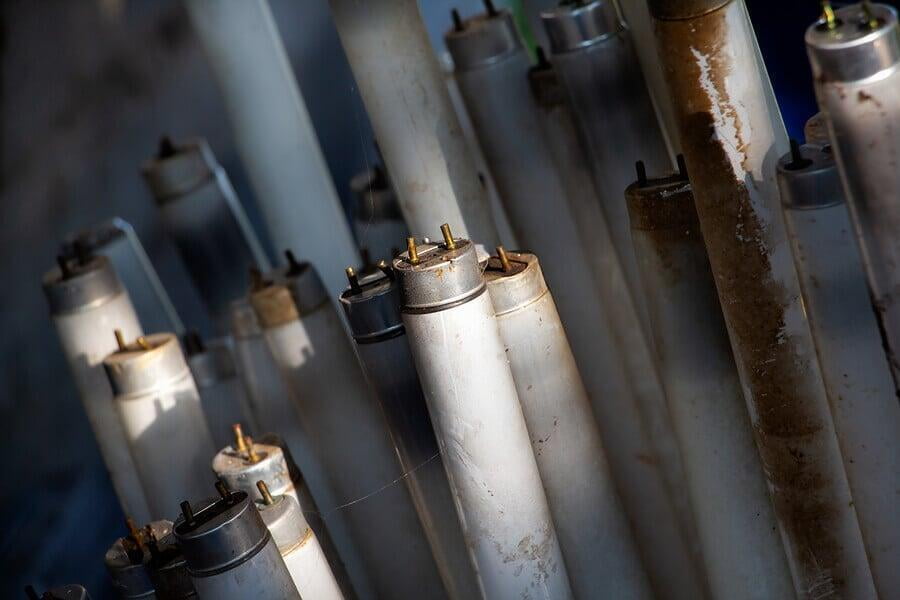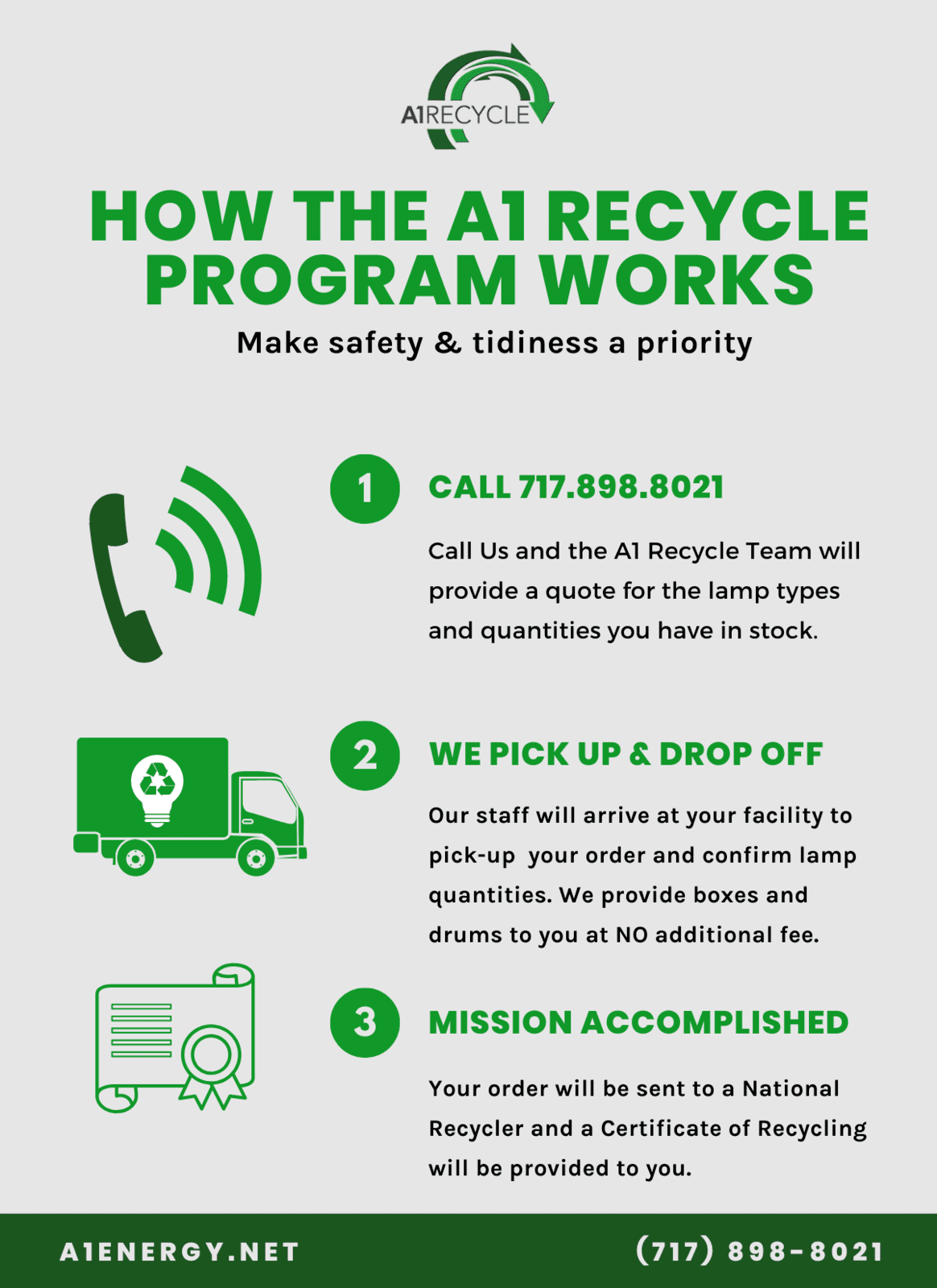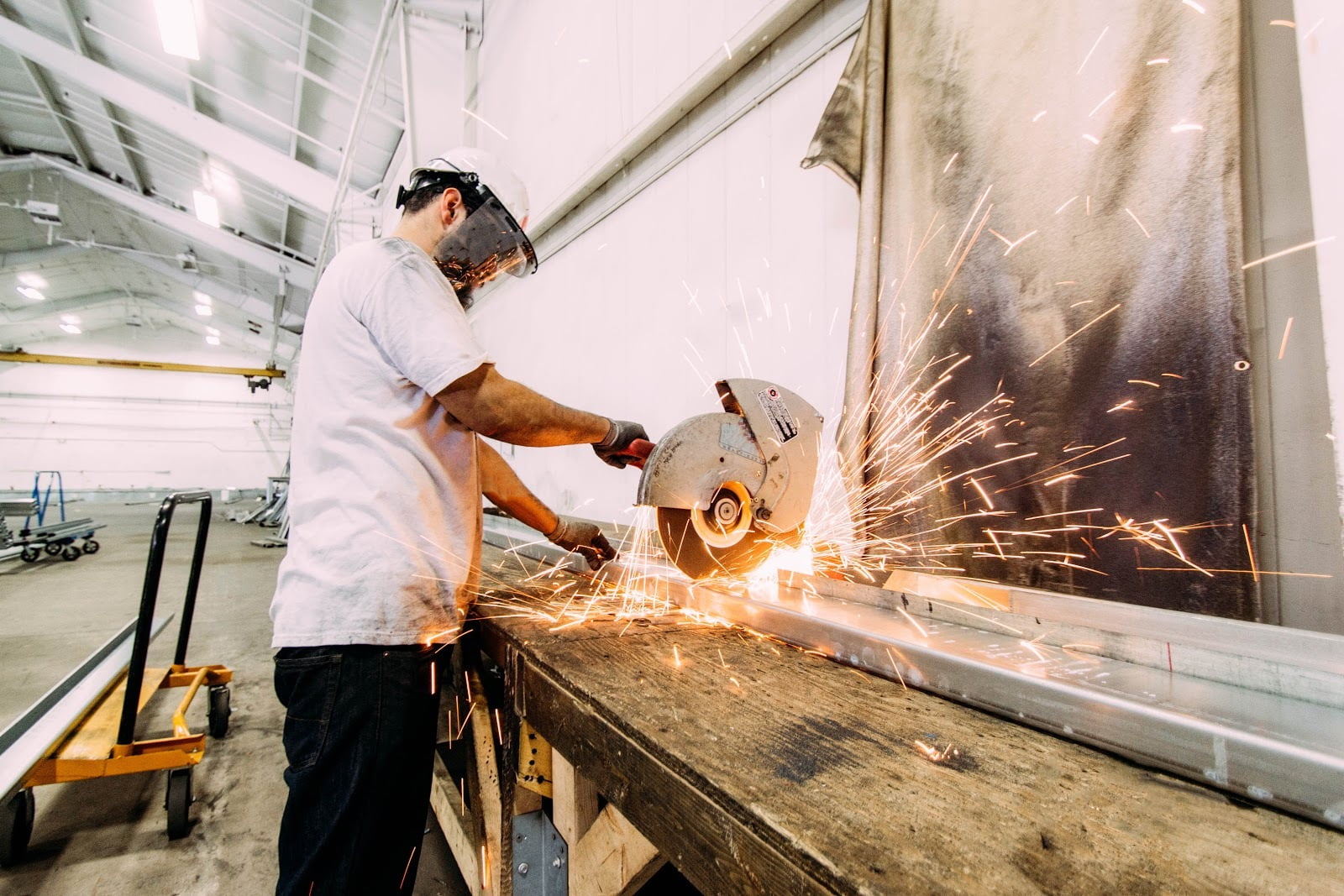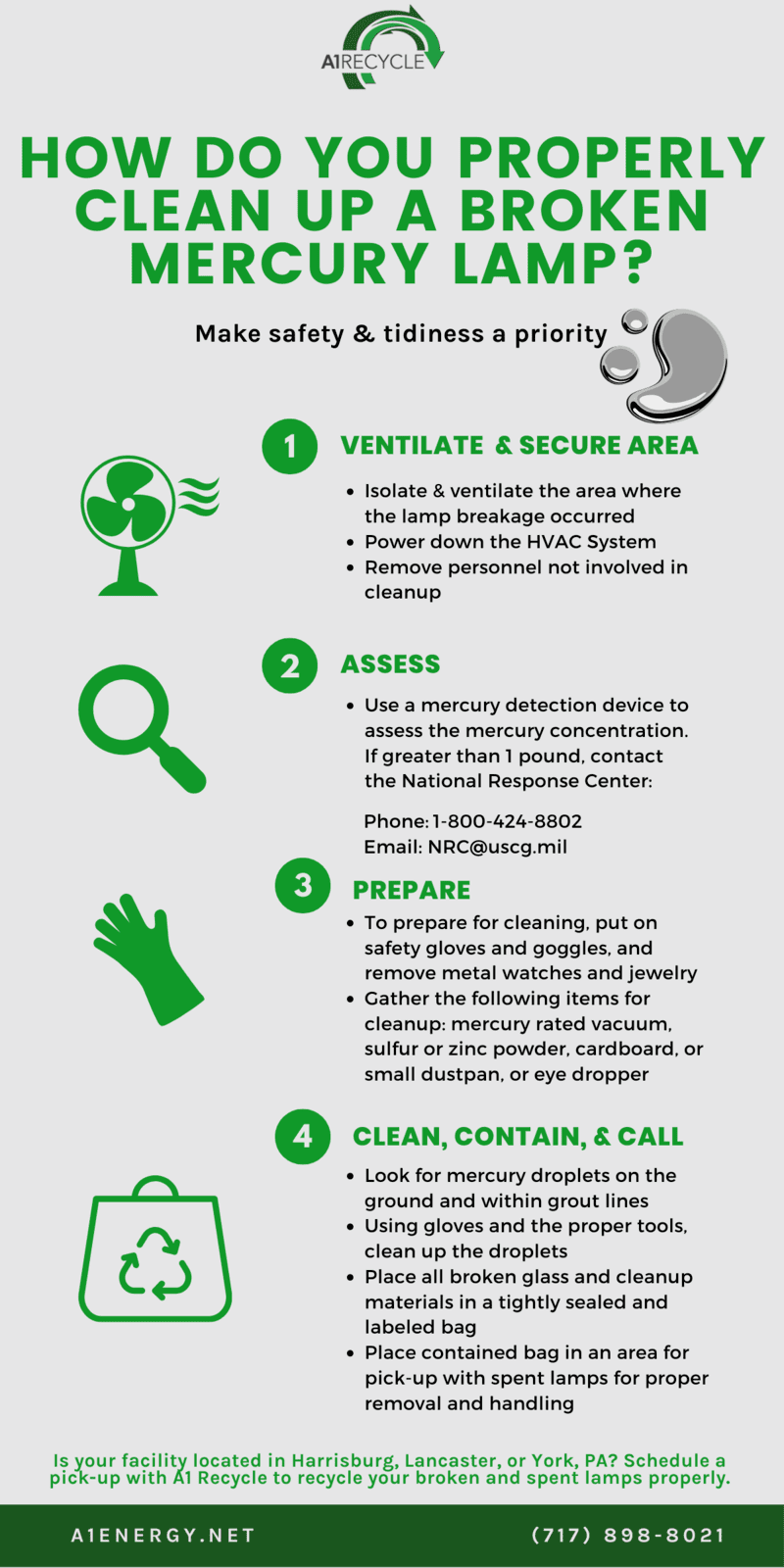
Keeping facilities tidy and reducing hazards are among the top of the list for facilities managers. Just another day on the job, right? Our job is to help our local facility managers keep things clean and flowing smoothly. Fluorescent lamps, e-waste, ballasts, and other universal hazardous waste can be a chore to organize, contain, document, and schedule for appropriate recycling.
At A1 Energy, we’re primarily focused on seeing that your facility's energy and lamp recycling programs are completely optimized, running in an efficient, reliable, and sustainable manner. Optimization includes helping your team, when ready, switch to lighting that lasts longer, ultimately requiring less maintenance in the immediate and long-term. If your facility still operates with an influx of fluorescent lights, we're here to guide you through the most common questions asked by facility managers. We're available to assist you in setting up a lamp recycling program that meets your custom needs and includes other items your facility may need help disposing of properly, such as spent ballasts, batteries, and office e-waste.
About the A1 Lamp Recycling Program
A1 Recycle's local commercial pick-up program is designed to meet your facility's specific needs. We specialize in supporting the York, Harrisburg, and Lancaster areas. If your facility is within this territory and you'd like us to drop off boxes and tailor a pick-up program according to your operations, please give us a call at (717) 898-8021.

Guide For Running a Successful Lamp Recycling Program in South Central Pennsylvania
Lamp recycling facility prep checklist:
Know and document the following details to base your recycling program on the precise needs of your particular facility:
Record the total fluorescent lamp count for the facility
Document the schedule and locations for changing out fluorescent lamps
Establish the frequency of lamp recycling for your facility (monthly, quarterly, annually)
Create a documented process for handling spent lamps
Dedicate location(s) where spent lamps stored before recycling
Provide employee education on proper handling of fluorescent lamps, breakage prevention, and breakage handling
Create hazardous waste compliance protocol with local, state, and federal regulations
Know and document the following details to base your recycling program on the precise needs of your particular facility:
Record the total fluorescent lamp count for the facility
Document the schedule and locations for changing out fluorescent lamps
Establish the frequency of lamp recycling for your facility (monthly, quarterly, annually)
Create a documented process for handling spent lamps
Dedicate location(s) where spent lamps stored before recycling
Provide employee education on proper handling of fluorescent lamps, breakage prevention, and breakage handling
Create hazardous waste compliance protocol with local, state, and federal regulations
What Types of Facilities Can Recycle Lamps With A1 Recycle?
While all lamps containing mercury are mandated to be recycled, the A1 Recycle program is tailored to assist the following facilities in meeting their particular recycling needs in keeping areas safe and clean, including:
Manufacturing & Industrial
Food & Farming
Hotels & Hospitality
Hospitals & Healthcare
Senior Living
K-12 School Districts
Colleges & Universities
Gyms & Sports
Commercial

What Types of Items Can I Recycle With the A1 Recycle Program?
The A1 Recycle Program accepts a wide array of lamps and universal waste. We will deliver boxes for local facilities to store and recycle the following items:
Fluorescent Lamps straight linear:
T12
T8
T5
U-Tubes, Circular, and Compact:
T12
T8
U tubes
Circular lamps
Compact fluorescents (CFL) including twin tube and biax lamps
HIDs:
Metal halide
High pressure sodium
Mercury vapor lamps
Other lamps:
Coated fluorescent
UV
Act
Germicidal
Low pressure sodium
Incandescent
Flood lamps
Ballasts:
Magnetic
Electronic
PCB & Non-PCB containing ballasts
Office E-Waste:
Office electronics
Computers
Spent batteries
Pennsylvania Regulatory Bodies for Hazardous Waste Disposal and Lamp Recycling
There are federal, state, and local regulating bodies that govern hazardous waste handling and recycling. Below are points of contact and relevant information on hazardous waste management for Harrisburg, York, and Lancaster, PA.
Environmental Production Agency Resources:
Resources for Hazardous Waste Management in PA:
Lake Erie Mercury Pollution Prevention Fact Sheet
Guidance Document, Fluorescent Lamp Recycling
Hazardous Waste Lamp Rule - EPA
Pennsylvania Department of Environmental Protection Home Page
Why is it important to properly recycle fluorescent lamps?
In addition to abiding by hazardous waste regulations, it’s crucial to avoid environmental contamination and neurotoxicity from the mercury contained in fluorescent bulbs. Proper storage and the implementation of recycling can help support hazardous waste spills from broken lamps. In turn, preventing lamps from breaking helps to prevent mercury and phosphor from seeping into groundwater, soil, and becoming vaporized into the air.
Safe handling and storing of spent lamps at your facility can be done in a number of ways, including:
Keeping your used lamps in boxes and drums to prevent them from breaking
Labeling boxes and keeping a tally to track the best pickup schedule, preventing overflowing and thus the probability of breakage
Keeping a clean designated area where spent lamp boxes are housed before pickup, informing employees about the dangers and proper handling of lamps
Contacting the A1 Recycle Program for pickup (Harrisburg, York, and Lancaster, PA)
Having a designated area and properly labeling fragile lamps can prevent mercury contamination. When lamps break, the dust and vapors released into the air are toxic, and can lead to bigger expenses that are preventable with proper handling and education.

Plan and Process For Managing Fluorescent Lamp Recycling
Lamp recycling is much easier with a simple plan and process in place. Keeping track of how many fluorescent lamps your facility generally goes through in a given time can help build the calendar of expected pickup dates your facility requires. Designating recycling areas and the exact number of boxes required makes it easy to keep areas neat and tidy. Facility managers can hang a checklist and box tally in the spent lamp area of the warehouse or office manager’s space to keep track of when it is time to call for recycling pickup.
How to Avoid Hazards and Safely Store Spent Lamps
As soon as spent lamps are removed and replaced, immediately place them into designated boxes and storage drums labeled and stored in designated areas. Make sure there’s a process in place where spent lamps are swiftly and safely delivered to their designated area. Never leave lamps unattended or in open, unsupervised areas where they risk being crushed, stepped on, or falling on the ground and breaking.
Having a plan and procedure for employees to know how to replace and handle fluorescent lamp burnouts is just as important as knowing how to handle breakage. You can accomplish this by incorporating the following:
Having a procedure to replace lamps, and a careful handling plan to place burned out lamps in correctly labeled boxes to be recycled
Placing lamps in designated areas that are safe and out of the way from being moved or accidentally mishandled
Preventing breakage of any sort that prevents exposure to toxic chemicals and mercury, and also saves money on pricier recycling fees for broken lamps
Placing used lamps in clearly marked and completely sealed boxes helps prevent leaks from breakage
Using a tally system and clearly marked boxes/drums to remind staff when it is time to call A1 Energy
How to Properly Clean Up a Broken Mercury Containing Lamp
Broken lamps contain mercury and are thus a health hazard. Proper cleanup and isolation of expelled mercury are important to keep staff safe. Mercury beads are difficult to locate, especially on concrete surfaces. Mercury is odorless and becomes gaseous at room temperature. In cases where an accident has occurred, being prepared with a procedural task list will make for a more manageable experience.
Here are some steps to take when a mercury lamp has been broken or compromised:
Step 1: Ventilate and Secure the Area
Isolate & ventilate the area where the lamp breakage occurred for 10 min to 24 hours
Power down the HVAC system
Remove personnel not involved in the cleanup
Step 2: Assess & Prepare
Use a mercury sensor to assess the mercury concentration levels
If greater than 1 pound was spilled, contact the National Response Center:
Phone: 1-800-424-8802 or Email: NRC@uscg.mil
To prepare for cleaning, put on safety gloves and goggles, and remove metal watches and jewelry
Gather the following items for cleanup: mercury rated vacuum, sulfur or zinc powder, stiff paper or cardboard, or a small dustpan, eye dropper, damp paper towel or sealable bag
Step 3: Clean & Contain
Look for mercury droplets on the ground and within grout lines
Using gloves and the proper tools, clean up the droplets
Place all broken glass and cleanup materials in a tightly sealed and labeled bag
Place contained bag in an area for pick-up with spent lamps for proper removal and handling
Finally: If your facility is located in Harrisburg, Lancaster, or York, PA, schedule a pick-up with A1 Recycle to recycle your broken and spent lamps properly by calling (717) 898-8021.

Keeping Track of Your Lamp Recycling Program and Hazardous Waste Compliance Certificates
The best way to know if your lamp recycling program is running effectively and efficiently is to measure it. Here’s are some helpful recommendations:
Keep track of how many lamp boxes and containers you need on a monthly, quarterly, or annual basis, depending on how often your facility requires lamp pick-up
Track lamp breakage and aim for full prevention of lamp breakage
Maintain proper paperwork and certification of lamp recycling
At A1 Recycling, we provide you with the recycling certification you need for your reporting records. We also maintain a hard copy file for you, as well as a cloud file of your recycling certificate, so that you always have a backup when you need it.
Conclusion
Lamp recycling programs help facility managers navigate the process of installing, removing, storing, and recycling fluorescent lamps. Having a documented, repeatable system and support of a recycling pick up program, makes lamp management easy for facility managers to execute. Keeping the lamp storage room free from clutter and cleared out at regular intervals is not only great for safety but allows for more time on the jobs that matter, and less time on emergency lamp breakages and cleanups.
To go a step further, the A1 Energy team assists facilities in lighting retrofit projects to remove the need for lamp recycling by replacing fluorescent lamps with high efficiency, long lasting LEDs. Our team of financial experts helps remove the upfront costs involved with this transition.
https://www.epa.gov/cfl/cleaning-broken-cfl#qihttps://www.aircycle.com/resources/state-regulations/pa.aspx
https://www.epa.gov/cfl/recycling-and-disposal-cfls-and-other-bulbs-contain-mercury
https://www.epa.gov/cfl/cleaning-broken-cfl
https://www.epa.gov/sites/production/files/2014-12/documents/k01005.pdf
https://archive.epa.gov/epawaste/hazard/web/html/index-49.html
https://www.govinfo.gov/content/pkg/FR-1999-07-06/pdf/99-16930.pdf
